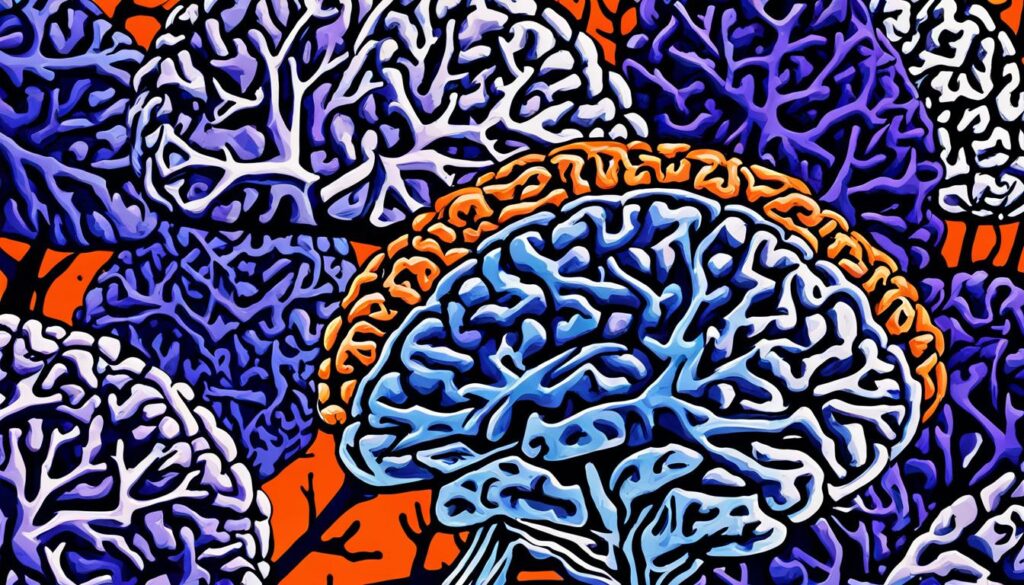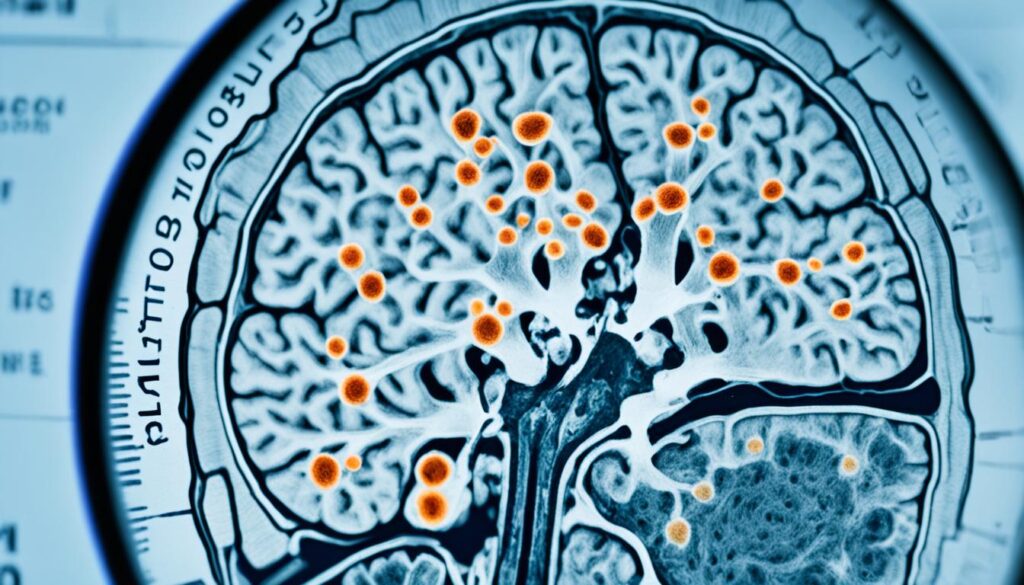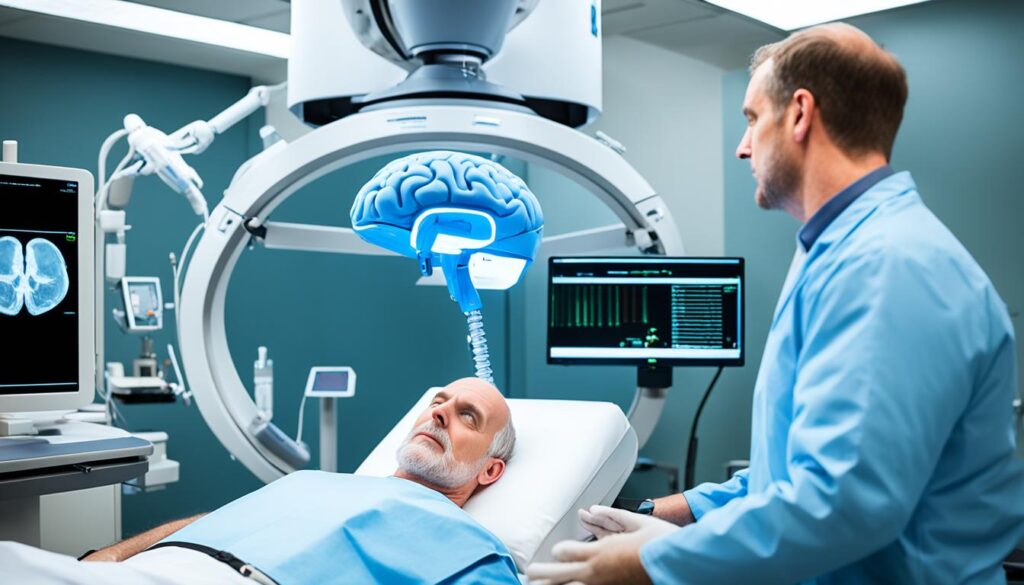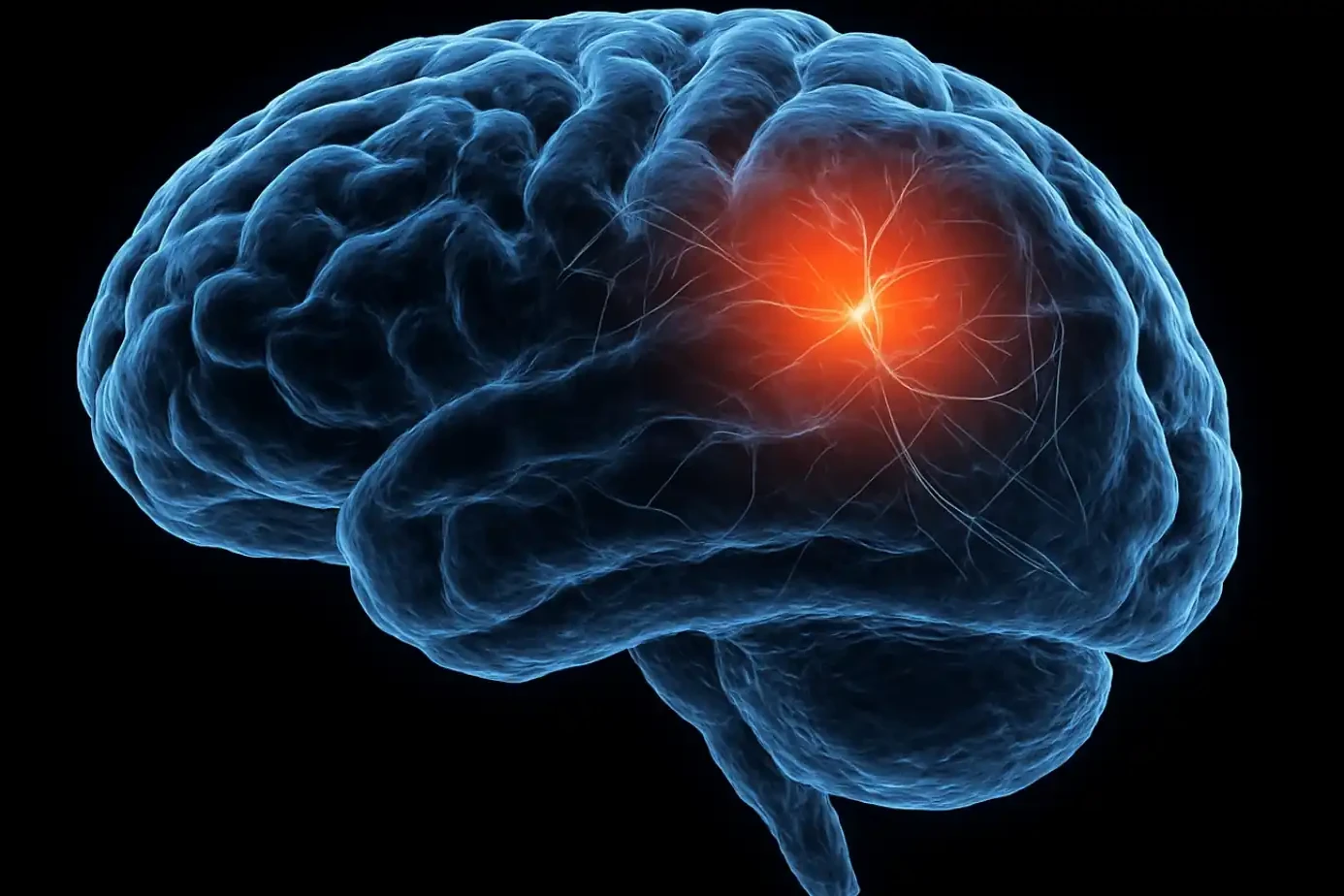Welcome to our comprehensive guide on types of brain tumors! In this article, I will provide detailed information about the various brain tumor classifications, such as benign and malignant tumors, to help you understand these conditions better. Whether you or a loved one are dealing with a brain tumor or simply seeking knowledge on the subject, this guide will provide valuable insights.
Brain tumors can be categorized into primary and metastatic tumors. Primary tumors originate from the brain or its surrounding tissues, while metastatic tumors occur when cancer cells from other parts of the body spread to the brain. It is crucial to understand the different types of brain tumors as it greatly influences the diagnosis and treatment options.
In the following sections, we will delve into the types of brain tumors, including benign and malignant tumors, and explore the other less common tumor types as well. We will also discuss the incidence and possible causes of brain tumors, symptoms to watch out for, the diagnosis process, available treatment options, and the prognosis and survival rates associated with brain tumors.
So, let’s get started by understanding the different types of brain tumors and how they impact individuals affected by these conditions. To provide a visual representation, here’s an infographic depicting the various brain tumor types.
Now, let’s dive into each classification of brain tumors to gain a comprehensive understanding of these complex conditions.
Table of Contents
ToggleTypes of Benign Brain Tumors
Benign brain tumors are noncancerous growths that usually grow slowly and do not spread to other tissues. Although they are not cancerous, these tumors can still cause complications due to their size and location, putting pressure on surrounding brain tissue.
There are several types of benign brain tumors:
- Chordomas
- Craniopharyngiomas
- Gangliocytomas
- Glomus jugulare tumors
- Meningiomas
- Pineocytomas
- Pituitary adenomas
- Schwannomas
Chordomas are rare tumors that typically develop along the spine or in the base of the skull. Craniopharyngiomas are tumors that occur near the pituitary gland and can affect hormone production. Gangliocytomas are rare tumors that arise from nerve cells. Glomus jugulare tumors develop in the jugular bulb, which is close to the inner ear. Meningiomas are the most common type of benign brain tumor and originate from the meninges, the protective layers of tissue that surround the brain and spinal cord. Pineocytomas are tumors that form in the pineal gland, a small gland located deep in the brain. Pituitary adenomas are tumors that grow from the pituitary gland, which regulates hormones. Schwannomas are tumors that arise from the Schwann cells that surround nerves.
Types of Malignant Brain Tumors
Malignant brain tumors are a serious and aggressive form of cancer that originate in the brain or its surrounding tissues. These tumors grow rapidly and have the potential to spread to other parts of the brain or the central nervous system. Timely diagnosis and immediate treatment are crucial for managing malignant brain tumors effectively.
The most common type of malignant brain tumor is glioma, accounting for a significant percentage of cases. Glioma includes various subtypes, such as astrocytomas, ependymomas, glioblastomas, and oligodendrogliomas. These tumors can be highly invasive and pose significant challenges to treatment.

In addition to gliomas, there are other types of malignant brain tumors that require attention and specialized treatment. Medulloblastomas are most commonly found in children and tend to develop in the cerebellum, affecting coordination and balance. Anaplastic tumors are aggressive and fast-growing, necessitating prompt treatment.
Due to the invasive nature of malignant brain tumors, treatment options often involve a combination of surgery, radiation therapy, and chemotherapy. The specific treatment plan depends on factors such as tumor size, location, and grade. It is vital to consult with a team of medical professionals who specialize in neurology and oncology to determine the most suitable treatment approach.
Managing malignant brain tumors requires a comprehensive and multidisciplinary approach. Ongoing research and advancements in medical science continue to improve treatment outcomes and give hope to individuals affected by these challenging conditions.
Other Types of Brain Tumors
In addition to benign and malignant brain tumors, there are other types of brain tumors that are less common. These include hemangioblastomas, rhabdoid tumors, pediatric brain tumors, and various brain tumors categorized by the World Health Organization (WHO) grading system. These uncommon brain tumors have unique characteristics, and their treatment requires specialized approaches.
Hemangioblastomas
Hemangioblastomas are rare brain tumors that originate from blood vessels in the brain or spinal cord. They are typically benign and slow-growing. Hemangioblastomas can occur sporadically or as a part of a genetic disorder called Von Hippel-Lindau disease.
Rhabdoid Tumors
Rhabdoid tumors are highly aggressive and rare brain tumors that mainly affect young children. They typically occur in the kidneys but can also develop in the brain. These tumors are challenging to treat and have a poor prognosis.
Pediatric Brain Tumors
Brain tumors in children can vary significantly from those in adults. Pediatric brain tumors encompass a wide range of uncommon tumor types, such as medulloblastomas, ependymomas, and gliomas. These rare brain tumors require a multidisciplinary approach involving pediatric neurosurgeons, oncologists, and other specialists.
Incidence and Causes of Brain Tumors
Brain tumors are a condition that can affect individuals of all ages. While they can occur at any stage of life, the incidence of brain tumors tends to increase with age. According to the National Cancer Institute, approximately 22,910 adults are diagnosed with brain and other nervous system tumors each year in the United States.
The exact causes of brain tumors are not fully understood. However, several factors have been identified that can contribute to the development of brain tumors. These factors include:
- Family history: Individuals with a family history of brain tumors may have a higher risk of developing the condition themselves.
- Exposure to radiation: Previous exposure to ionizing radiation, such as radiation therapy for other types of cancer or radiation fallout from nuclear accidents, may increase the likelihood of developing a brain tumor.
- Chemical exposure: Certain chemicals, such as vinyl chloride and formaldehyde, have been linked to an increased risk of brain tumors.
It is important to note that while these factors may increase the risk of developing a brain tumor, they do not guarantee the development of the condition. Many individuals with these risk factors never develop a brain tumor, while others without any known risk factors may still be diagnosed with the condition.
| Age Group | Estimated Incidence of Brain Tumors (Per 100,000 Population) |
|---|---|
| 0-14 years | 2.6 |
| 15-29 years | 5.7 |
| 30-44 years | 8.2 |
| 45-59 years | 19.6 |
| 60-74 years | 38.8 |
| 75+ years | 51.4 |
Symptoms of Brain Tumors
The symptoms of brain tumors can vary depending on the location, size, and grade of the tumor. Early detection of these symptoms is crucial for prompt medical intervention and improved prognosis. Here are some common symptoms experienced by individuals with brain tumors:
- Headaches: Persistent or severe headaches are a common symptom of brain tumors. They can worsen over time and may not respond to regular pain relievers.
- Nausea: Feeling nauseous or vomiting unrelated to any other known cause can indicate a brain tumor.
- Vision Problems: Blurred vision, double vision, or changes in peripheral vision can be signs of a brain tumor affecting the optic nerves or visual pathways.
- Motor Difficulties: Weakness or numbness in the limbs, difficulty with balance or coordination, and problems with fine motor skills can be symptoms of brain tumors.
- Memory Problems: In some cases, brain tumors can cause memory loss, difficulty concentrating, and problems with cognitive functions.
- Personality Changes: Changes in behavior, mood swings, irritability, and unexplained emotional outbursts can be indicators of brain tumors affecting certain parts of the brain.
- Seizures: Seizures that occur suddenly in individuals without a history of epilepsy can be a sign of a brain tumor.
- Hearing Problems: Hearing loss, ringing in the ears (tinnitus), or other auditory disturbances may be associated with certain brain tumors.
It is important to note that the specific symptoms experienced may differ from person to person. If you or someone you know is experiencing any of these symptoms, it is crucial to consult a healthcare professional for a comprehensive evaluation and diagnosis.
Diagnosis of Brain Tumors
When it comes to diagnosing brain tumors, a comprehensive evaluation is essential. The process involves various medical examinations and imaging tests that help determine the presence and characteristics of the tumor. Additionally, a biopsy may be performed to precisely identify the type and grade of the tumor. This diagnostic phase plays a crucial role in formulating an appropriate treatment plan tailored to the patient’s specific needs and condition.
During the diagnosis of brain tumors, some of the key procedures include:
- Physical Examination: A thorough physical examination is conducted to assess symptoms, neurological function, and overall health.
- Medical History Review: The medical history of the patient is carefully reviewed to understand any familial or personal risk factors that may contribute to the development of brain tumors.
- Imaging Tests: Various imaging tests are utilized to capture detailed images of the brain and identify any abnormal growths. Commonly used imaging tests include:
| Imaging Test | Purpose |
|---|---|
 | Computed Tomography (CT) Scan |
 | Magnetic Resonance Imaging (MRI) Scan |
Biopsy: In some cases, a biopsy may be necessary to extract a sample of the tumor tissue for further analysis. This procedure helps determine the exact type and grade of the brain tumor, which is crucial for determining the most suitable treatment approach.
The accurate diagnosis of brain tumors lays the foundation for informed decision-making and personalized treatment strategies. It allows healthcare professionals to understand the specific characteristics of the tumor and develop an effective treatment plan tailored to each patient’s unique circumstances.
Treatment Options for Brain Tumors
When it comes to treating brain tumors, there are several options available depending on the specific characteristics of the tumor and the patient’s overall health. The primary goal of treatment is to effectively manage symptoms, remove or shrink the tumor, and improve the patient’s quality of life. Some common treatment options for brain tumors include:
Surgery
Surgery is often the first line of treatment for brain tumors. The surgical procedure aims to remove as much of the tumor as possible without causing damage to healthy brain tissue. In some cases, complete tumor removal may not be possible due to the tumor’s location or other factors. However, even partial removal can provide significant relief from symptoms and improve outcomes.
Radiation Therapy
Radiation therapy involves the use of high-energy beams to target and kill cancer cells. It is a common treatment modality for brain tumors, especially when the tumor is inoperable or cannot be completely removed. Radiation therapy can help shrink the tumor, relieve symptoms, and slow down tumor growth. It is often used in combination with other treatment modalities for better outcomes.
Chemotherapy
Chemotherapy is a systemic treatment that uses drugs to kill cancer cells or stop their growth. It is often used in cases where the tumor has spread to other parts of the brain or the body. Chemotherapy can be administered orally or intravenously, and the choice of drugs depends on the specific type of tumor. It is often used in conjunction with surgery or radiation therapy to enhance effectiveness.
Targeted Therapy
Targeted therapy is a treatment approach that focuses on specific changes within cancer cells that allow them to grow and divide uncontrollably. By targeting these specific changes, targeted therapy drugs can block the growth and spread of cancer cells while causing fewer side effects compared to traditional chemotherapy. Depending on the genetic profile of the tumor, targeted therapy may be an option for certain patients.
Immunotherapy
Immunotherapy is a rapidly evolving field in cancer treatment that harnesses the body’s immune system to fight cancer cells. It involves using drugs or other treatments to stimulate the immune system’s response against cancer cells. While still being researched for brain tumors, immunotherapy has shown promise in certain cases and may be considered as a treatment option in specific situations.
Supportive Care
In addition to the specific treatment modalities mentioned above, supportive care plays a crucial role in the overall management of brain tumors. Supportive care focuses on addressing the patient’s physical, emotional, and psychological needs, providing pain management, symptom control, and psychosocial support. It aims to improve the patient’s overall well-being and enhance their quality of life throughout the treatment process.
It is important to note that the choice of treatment for brain tumors is personalized and depends on various factors. A multidisciplinary team of healthcare professionals, including neurosurgeons, radiation oncologists, medical oncologists, and supportive care specialists, works together to develop an individualized treatment plan for each patient.

Prognosis and Survival Rates of Brain Tumors
When it comes to brain tumors, the prognosis and survival rates can vary depending on multiple factors. These include the type and grade of the tumor, age, overall health, and response to treatment. It’s important to note that survival rates are highly individualized, and each person’s journey is unique.
Advances in medical technology and treatment approaches have significantly improved survival rates and the overall quality of life for brain tumor patients in recent years. With early detection, timely intervention, and personalized treatment plans, the outlook for patients has become more promising.
Factors Affecting Prognosis
The prognosis for brain tumor patients is influenced by various factors:
- Type and grade of the tumor: Different types of brain tumors have different growth patterns and behaviors, impacting the prognosis. High-grade tumors are generally more aggressive and difficult to treat.
- Age: Younger patients with brain tumors tend to have better overall survival rates compared to older patients.
- Overall health: The general health and medical condition of a patient may affect their ability to tolerate treatment and respond to it effectively.
- Response to treatment: How well a patient responds to the prescribed treatment, including surgery, radiation therapy, chemotherapy, or targeted therapy, plays a significant role in determining their prognosis.
Survival Rates
Survival rates for brain tumor patients can vary widely. While statistics can provide a broad perspective, it’s important to remember that individual cases may deviate from these averages. The numbers provided are general estimates and should not be considered definitive.
Below is a table summarizing the 5-year survival rates for different types of brain tumors:
| Type of Brain Tumor | 5-Year Survival Rate |
|---|---|
| Low-grade gliomas | Approximately 75% |
| High-grade gliomas (including glioblastoma) | Less than 10% |
| Meningiomas | Approximately 85% |
| Medulloblastomas | Varies depending on the subtype, with survival rates ranging from 50-70% |
| Pituitary adenomas | Up to 90% with proper treatment |
It’s important to consult with a medical professional for an accurate assessment and outlook based on specific circumstances. The prognosis and survival rates for brain tumor patients continue to improve as scientific advancements pave the way for better treatments and therapies.
Conclusion
Understanding brain tumors is crucial for individuals and their families affected by these conditions. This comprehensive guide to brain tumors has provided valuable information on the different types of brain tumors, their diagnosis, treatment options, and prognosis.
Each type of brain tumor requires a specific approach to diagnosis and treatment. Early detection plays a vital role in ensuring the best possible outcome. Therefore, it is essential for individuals to be aware of the symptoms and risk factors associated with brain tumors, as early intervention can significantly impact treatment success.
Advancements in medical science and ongoing research continue to improve the prognosis and quality of life for individuals living with brain tumors. Medical professionals are dedicated to developing innovative treatment strategies, such as targeted therapy and immunotherapy, which hold great promise for the future.
Together, with increased understanding of brain tumors and ongoing support, individuals and their families can navigate the challenges associated with this condition and strive for the best possible outcome.
FAQ
What are the different types of brain tumors?
There are various types of brain tumors, including primary and metastatic tumors. Primary tumors originate from the brain or its surrounding tissues and can be categorized as glial or non-glial, benign or malignant. Metastatic tumors occur when cancer cells from other parts of the body spread to the brain and are considered malignant.
What are some common types of benign brain tumors?
Some common types of benign brain tumors include chordomas, craniopharyngiomas, gangliocytomas, glomus jugulare tumors, meningiomas, pineocytomas, pituitary adenomas, and schwannomas. While these tumors are noncancerous, they can still cause complications by putting pressure on surrounding tissues.
What are the most prevalent types of malignant brain tumors?
The most prevalent type of malignant brain tumor is glioma, which includes astrocytomas, ependymomas, glioblastomas, and oligodendrogliomas. Other types of malignant brain tumors include medulloblastomas and anaplastic tumors. These tumors require immediate and aggressive treatment due to their invasive nature.
Are there any other types of brain tumors?
Yes, apart from benign and malignant brain tumors, there are other types of brain tumors that are less common. These include hemangioblastomas, rhabdoid tumors, pediatric brain tumors, and various brain tumors categorized by the World Health Organization (WHO) grading system. These tumors have different characteristics and require specialized treatment approaches.
Who is at risk for developing brain tumors?
Brain tumors can affect people of all ages, but the incidence increases with age. According to the National Cancer Institute, approximately 22,910 adults are diagnosed with brain and other nervous system tumors each year in the United States. Certain risk factors, such as family history, exposure to radiation, and chemical exposure, can increase the likelihood of developing a brain tumor.
What are the common symptoms of brain tumors?
The symptoms of brain tumors vary depending on the location, size, and grade of the tumor. Common symptoms include headaches, nausea, vision problems, motor difficulties, memory problems, personality changes, seizures, and hearing problems. The specific symptoms experienced may differ from person to person, and early detection is crucial for prompt medical intervention.
How are brain tumors diagnosed?
The diagnosis of a brain tumor involves a thorough physical examination, medical history review, and several imaging tests, such as CT scans and MRI scans. A biopsy may also be performed to determine the type and grade of the tumor. The diagnosis process is crucial in developing an appropriate treatment plan.
What are the treatment options for brain tumors?
The treatment of brain tumors depends on various factors, including the type, size, location, and grade of the tumor, as well as the patient’s overall health. Treatment options may include surgery, radiation therapy, chemotherapy, targeted therapy, immunotherapy, and supportive care. The goal of treatment is to remove or shrink the tumor and manage symptoms effectively.
What is the prognosis for brain tumor patients?
The prognosis for brain tumor patients depends on several factors, including the type and grade of the tumor, age, overall health, and response to treatment. Survival rates vary greatly from person to person and are influenced by these factors. Advances in medical technology and treatment approaches have improved survival rates and overall quality of life for brain tumor patients in recent years.
Why is understanding the different types of brain tumors important?
Understanding the different types of brain tumors is essential for individuals affected by these conditions and their families. Each type of brain tumor requires a specific approach to diagnosis and treatment, and early detection is crucial for the best possible outcome. Ongoing research and advancements in medical science continue to improve the prognosis and quality of life for individuals living with brain tumors.
Source Links
About The Author

This article is medically reviewed by Dr. Chandril Chugh, Board-Certified Neurologist, providing expert insights and reliable health information.
Dr. Chandril Chugh is a U.S.-trained neurologist with over a decade of experience. Known for his compassionate care, he specializes in treating neurological conditions such as migraines, epilepsy, and Parkinson’s disease. Dr. Chugh is highly regarded for his patient-centered approach and dedication to providing personalized care.
→ Book a consultation to discover which remedies suit your needs best.




